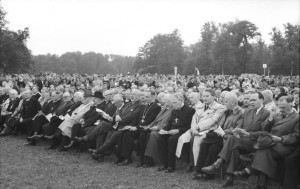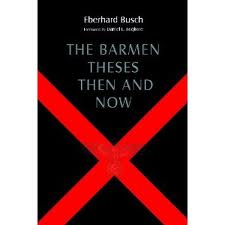ACCH Quarterly Vol. 18, No. 2, June 2012
Conference Paper: “Martin Niemöller in America, 1946-1947: ‘A Hero with Limitations’”
Plenary Session: Disputed Memories of Complicity and Righteousness, 42nd Annual Scholars’ Conference on the Holocaust and the Churches, May 12-14, 2012.
By Matthew D. Hockenos, Skidmore College
From the mid-1930s to the early 1980s Martin Niemöller was a cause célèbre in the United States. He is best known in America as the pugnacious Prussian minister who Hitler imprisoned in a concentration camp for eight years and after his liberation made the famous postwar confession:
First they came for the Socialists, and I did not speak out –
Because I was not a Socialist.
Then they came for the Trade Unionists, and I did not speak out –
Because I was not a Trade Unionist.
Then they came for the Jews, and I did not speak out –
Because I was not a Jew.
Then they came for me – and there was no one left to speak for me.[1]
From 1946 until his death in 1984 Niemöller visited the United States regularly. None of his visits was as wrought with controversy as his very first. Niemöller first set foot in the U.S. in late 1946 to embark on a speaking tour sponsored by the Federal Council of Churches (FCC). For the next five months his every move was followed closely in the local and national media including the New York Times, The Washington Post, and Time magazine as well as in religious publications like The Christian Century. The average American was more likely to know more about Martin Niemöller than about any other German living in the immediate postwar era. When Hitler locked him up in the notorious Sachsenhausen concentration camp in 1938 as his own private prisoner, churches across America and the world prayed for his release. When he toured the United States after gaining his freedom, many American Protestants greeted him like a rock star. Tens of thousands of enraptured fans attended his addresses and listen to him on the radio. But many other Americans, including some very prominent ones, such as Eleanor Roosevelt and Rabbi Stephen Wise, called into question Niemöller’s resistance credentials and voiced their adamant opposition to his visit.
In the1930s Niemöller became a hero in the U.S. almost overnight as word spread about his leadership of the Confessing Church and his defiance of Hitler. Under sensational headlines declaring “Protestants Push Fight Upon the Nazis” and “Insurgent Pastors Disobey the Reich Bishop’s Orders” the print media followed the dramatic events of the German Church Struggle and its increasingly famous personality. Although much of the early reporting was misinformed and often hagiographic, Americans were inundated with news about Niemöller’s plight and the Church’s “resistance.”
On July 1, 1937 the Gestapo arrested Niemöller and held him for eight months in Moabit prison. He was tried in early 1938 for “causing unrest among the people” among other things. Although exonerated of the charges later that month, Hitler ordered him re-arrested in March 1938 and imprisoned him in Sachsenhausen as his own private prisoner. The Federal Council of Churches of Christ reacted to Niemöller’s imprisonment by calling on the churches of America to hold special prayer vigils and ring the church bells. Throughout his years of captivity American Protestants commemorated various Niemöller anniversaries: his birthday, the original date of his arrest, the day Hitler declared that Niemöller was his private prisoner, etc. Henry Smith Leiper, executive secretary for church relations in the FCC, exhorted Protestant ministers to “preach sermons on the modern Luther.”[2] On Sunday March 5, 1939, the second anniversary of Niemöller’s imprisonment in Sachsenhausen, Presbyterian Rev. John Paul Jones of the Union Church in Bay Ridge Brooklyn took it one step further by re-enacting Niemöller’s arrest. When pastor Jones mounted his pulpit that Sunday morning he appeared to be seized and dragged away by two men wearing Nazi uniforms. He then proceeded to give his sermon from behind a replica of a prison door with a barred window and “Sachsenhausen” inscribed over the door.[3]
Although there seemed to be no limit to the exaltation bestowed on Niemöller’s acts of defiance, there were, to be sure, some critics who pointed to his ardent love for his Fatherland and his enthusiastic participation in the unrestricted submarine warfare in World War One, for which he received an Iron Cross. Samuel Volkman, a rabbi in Chicago, however, took aim at Niemöller’s antisemitism, a topic rarely discussed in the American press. In a letter to The Christian Century Rabbi Volkman wrote:
I note from your issue of March 1, 1939, that the Federal Council of Churches is inviting the churches across America to give special recognition to Pastor Martin Niemöller and the cause for which he stands. As a rabbi, nothing would give the writer greater pleasure than to join Christian brethren in honoring one of the few exemplars of true religious heroism in our day. But in thumbing through the sermons of Niemöller [collected in the book Here I Stand], I came upon this passage “We speak of the ‘eternal Jew’ and conjure up the picture of a restless wanderer who has no home and can find no peace. We find a highly gifted people which produces idea after idea for the benefit of the world, but whatever it takes up becomes poisoned, and all that it ever reaps is contempt and hatred because ever and anon the world notices the deception and avenges itself in its own way.” (Here I Stand, p. 195) . . . [Rabbi Volkman then goes on to ask] Is the spiritual heritage of Israel a well of poison? . . . Who but the bigot will deny that [this] is as malevolent as it is unjust? Nor is this the only passage of its kind in the book. It is hoped that when the churches of America unite to do honor to the spirit of Niemöller, they will dissociate themselves from what can be regarded as nothing less than a particularly obnoxious kind of sanctimonious froth.[4]
What many Americans found more distressing than Niemöller’s antisemitism was his decision at the outbreak of the Second World War to volunteer his services to the German Navy to fight for his Fatherland. The editors of The Christian Century and Karl Barth in The Watchman Examiner tried to explain to their readers that Niemöller was, in fact, not an out-and-out anti-Nazi but rather a critic of Hitler’s church policy and that his offer to enlist in the Navy was simply proof of this.
If the American public was troubled by Niemöller’s “latest adventure,” as Karl Barth put it, it didn’t seem to dampen their overall enthusiasm for him. On December 23, 1940, Niemöller’s image appeared on the cover of Time magazine with the headline: “Martyr of 1940: In Germany only the cross has not bowed to the swastika.” The accompanying article quoted Niemöller’s famous challenge to Hitler, ”Not you, Herr Hitler, but God is my Führer.”
A flurry of books on Niemöller appeared in U.S. bookstores in the early 1940s. Popular biographies such as Basil Miller’s Martin Niemoeller: Hero of the Concentration Camp (1942) and Leo Stein’s fabrication I Was in Hell with Martin Niemoeller (1942) exalted his piety and courage. “Hitler may break his body, but never his soul,” Miller proclaimed to her enthusiastic readers. Ads appeared in newspapers proclaiming: “He Wouldn’t ‘Heil Hitler’ so Rev. Martin Niemoller begins his 7th year in a German Prison Camp – Remember Martin Niemoller!!” Films, such as Pastor Hall, and plays, such as God is my Fuehrer depicted his heroic struggle.
Churches across America breathed a collective sigh of relief when they learned that Niemöller had survived Dachau and had been taken into American custody after nearly being executed by the SS in northern Italy. The Washington Post reported that “When Americans read that their own troops . . . had found the celebrated Pastor Martin Niemöller, it was as though a grave had opened.” The Post predicted Niemöller would become “the advocate of his people in their hour of disillusion and despair, a witness to the world that, if German human nature is capable of the most bestial evil, it is also capable of great moral heroism.”[5]
On June 5, 1945 Niemöller granted an interview to dozens of British and American war correspondents gathered at a hotel in Naples, Italy, where Niemöller was awaiting authorization by the Americans to return to his family in Germany. In the interview he acknowledged that prior to the Nazis coming to power he “had nourished the hope that National Socialism, if it had gone the right way, might have developed into a system for creating good for the German people.”[6] He told the reporters that Hitler had deceived him. He insisted that most Germans, including himself, were ignorant of the scale of the atrocities that the Nazis had carried out and shocked by what they saw when the Allies liberated the camps. And because most Germans were ignorant of the atrocities, Niemöller explained, they don’t feel guilty. He declared that his own objections to Nazism were religious and not political. He claimed that he was not interested in politics but opposed the state’s encroachment in the affairs of the church. He admitted that from his cell in Dachau he offered his services to the German Navy when the war began. “If there is a war,” Niemöller declared, “a German doesn’t ask is it just or unjust, but he feels bound to join the ranks.” He claimed that the German people were ill suited to live under a Western form of democracy and even suggested that Germans preferred authoritarian rule. And finally, he said that what Germans needed now was help, not punishment, and that he hoped to visit England and the United States to enlist Brits and Americans in his efforts to secure food and proper clothing for Germans. He concluded, “The world will be astonished when it sees how many good people are left in Germany.”[7]
Although many of Niemöller’s devotees remained faithful to him despite the interview, the new Niemöller had his share of critics now, and some in very influential positions. Marshall Knappen, Director of the Education & Religious Affairs Branch of the American Occupation Forces, had a sit down with Niemöller on June 18 and concluded that “Niemöller, the religious leader and Confessional martyr is to be clearly distinguished from Niemöller the politically-minded retired naval officer. The one is to be accorded the freedom and respect which is due. The other . . . is to be watched carefully.”[8] Sylvester C. Michelfelder, President of the Council of Lutheran Churches in the United States, recorded in his diary on July 26, 1945, “Niemöller has come into disfavor pretty much because of his unfortunate interview with the Press in Italy. There he said, ‘My Soul belongs to God but my body to the State.’ This in America and Britain has caused much offense.”[9] General Lucius Clay, the American military governor, expressed reservations in September 1945 about Niemöller’s politics, stating: “While permitting Niemöller to take active leadership in religious affairs, we have not felt it is advisable to utilize his services in other fields as yet. While his anti-Nazi stand was demonstrated fully by his own actions, it is still too early to predict as to his wholehearted rejection of the militaristic and nationalistic concepts of the former German state.”[10]
Ewart E. Turner, an American Methodist pastor who had served as minister of the American Church in Berlin from 1930-34, visited the Niemöllers in Germany after the interview and found him to be deeply depressed. His wife, Else, said that “He sees everything black.”[11] There were several reasons for his despair, including the harsh treatment of the U.S. Occupational Forces, the unrepentant nature of the clergy and the German population in general, the death of one son and the unknown status of another in a Soviet POW camp.
The reaction of the American was scathing. The debacle of Naples interview severely tarnished Niemöller’s reputation and led some to conclude, along with the New York Times, that he was not suited “to be a leader in the moral reconstruction of his country.”[12] His assertion that Germany was unsuited for democracy caused the greatest concern. “If a democratic system cannot be erected in Germany Europe will be right back where it started from, and Germany must be continuously policed or periodically chastened by war.”[13] He was, as the New York Times article concluded, a hero but “a hero with limitations.”[14] Time magazine opened its article on the interview with the following: “Pastor Martin Niemöller, the one German whom Christians everywhere had respected, shocked a lot of people last week” (emphasis added). The editors of the San Jose News concluded, “We think that Rev. Niemöller is correct in saying that the Germans are not repentant and have learned little or nothing from their defeat. He may be correct in saying they are incapable of democracy. If they are thus unrepentant and incapable of democracy, then it is up to the Allies to provide them for a long time with the authority and leadership for which Rev. Niemöller says they yearn-an authority and leadership that will keep them out of further mischief.”[15] Niemöller’s disastrous interview led many Americans to conclude that if Niemöller was the best that Germany had to offer then a long and severe occupation of the country would be necessary.
Eleanor Roosevelt went so far as to describe Niemöller’s statements as “almost like a speech by Mr. Hitler.” And she went on to say, “Pastor Niemöller sounds to me like a gentleman who believes in the German doctrine of the superiority of race.”[16]
Amid the controversy over the interview, Niemöller and his wife accepted an invitation to visit the United States in late 1946 and early 1947 under the auspices of the Federal Council of Churches. During the lecture tour the Niemöllers spoke to enraptured church groups in more than a dozen states from the Northwest to the Southeast. Ewart E. Turner accompanied the Niemöllers on their American tour and described the Niemöller’s visit as “a spiritual atomic eruption.” Turner advised local church leaders scheduled to host a Niemöller visit, “Don’t let this spirit of Pentecost take you by surprise. Prepare for it with all the traditional ingenuity and foresight of American church life at its best.”[17]
Although the Federal Council of Churches received hundreds of requests for Niemöller to speak in various cities and churches across the United States, the visit was laden with controversy. Even before he arrived, opinion about his impending visit was polarized. Despite the flood of protests received by the Secretary of State, the Niemöllers were the first German civilians to be allowed entrance into the U.S. under auspices other than U.S. Armed Forces. Niemöller came to the United States as the vice-president of the Council of the Evangelical Church in Germany and the head of its department for relations with foreign churches. The stated purpose was to thank American churches for their support and assistance during Hitler’s reign and in the immediate postwar years. But attacks by such prominent figures as Eleanor Roosevelt resulted in a widely publicized debate over Niemöller and the purpose of his trip. On the day of Niemöller’s first public address in the U.S. Mrs. Roosevelt again raised her voice in protest. “One may applaud his bravery and his devotion to his church, but one can hardly applaud his attitude on the Nazi politics, and I cannot quite see why we should be asked to listen to his lectures. I am sure he is a good man according to his lights, but his lights are not those of the people of the United States who did not like the Hitler political doctrines.”[18]
Abundantly aware of the need to win over the American people, Niemöller did his best to avoid the mistakes he made in Naples. First, he refused to partake in any impromptu interviews where he might go off message. Second, all of his lectures and sermons were written down in advance and read virtually verbatim rather than ad-libbed. And finally, in the dozens of lectures, speeches, and sermons he gave in cities across the United States he continually returned to several themes that American churchgoers would likely find reassuring. That is not to say that his addresses lacked any fire or controversy, but rather that he tried to steer clear of any overtly political message that might offend his audience.
So what did Niemöller say to his American audiences? From his very first address at the biennial meeting of the Federal Council of Churches of Christ in America in early December 1946 to his last in May 1947, he typically began by thanking Americans for their prayers of support during his period of imprisonment and thanking the FCC for inviting him to United States. He emphasized that it was a combination of the prayers from abroad and his faith in God that sustained him during his years of imprisonment. He described how Hitler’s persecution of the German churches sparked an opposition movement within the churches and a new sense of faith in the Word of God. He highlighted the resistance mounted by the Confessing Church against the Nazi state while acknowledging that it was a minority of pastors and congregations that took part in the opposition; he drew attention to the 1934 Barmen Declaration and its proclamation of the absolute sovereignty of Christ as the backbone of the Confessing Church. He often told audiences of his own personal acts of defiance like preaching the Word of God to fellow inmates in the concentration camps or how he directly confronted Hitler at a 1934 meeting, telling him, “Mr. Chancellor, God himself has entrusted us with the responsibility for our nation, and no power and no authority in the world is entitled to take it from us.”[19] To his audience in Davenport Iowa he declared that despite Hitler’s attempt to destroy the churches, “the Word of God can’t be bound and can’t be murdered.”[20]
Although he devoted greater space to the Church opposition than to its complicity in Nazism, he frequently acknowledged his share of guilt and the guilt of his church and the German nation for the devastation in Europe; he pointed to the Stuttgart Declaration of Guilt of October 1945 as evidence that the leaders of the Protestant Church recognized their share of guilt. He emphasized the importance of reconciliation between God and man, between nations that had recently been at war, and between German and foreign churches. One important reason for his trip to the United States was to demonstrate that “God’s plan for Christian brotherhood doesn’t stop short at the boundaries of nations nor at the borders of continents.”[21] In addition to the ecumenical vitality of the universal church, he commended the non-denominational character of the Confessing Church and criticized the barriers set up that divide denominations.
When he met with groups of pastors or other churchmen and women, a prominent message was the need for the church to play a role in public affairs. Over and over he lamented that since the French Revolution religion had become a private affair resulting in an absence of moral and ethical responsibility in public matters. The absence of the commandments in public life, Niemöller explained, left people without any sense of direction leading them to embrace demagogues, who seemed to have all the answers. In his address to pastors in Rochester, N.Y. on February 25, 1947, he exclaimed that, “Because the commandments, the moral commandments and ethical commandments of God, were no longer acknowledged as valid for public life, humanity tried in a last decisive step to establish a new moral basis for public life in installing one person, Adolph Hitler.” The church, he went on, was particularly to blame for allowing this state of affairs to develop. Christianity, he insisted, was responsible for the disaster in central Europe because it did not carry out its duties to remind the world about the commandments.[22]
Niemöller tried to reassure his audiences that the German churches – at least those associated with the Confessing Church – had learned this lesson but he was worried about whether or not the average German was really learning any lessons from the past. The reason for this concern was that Germans were suffering horribly and that the danger existed that in their wretchedness they might easily fall pray to this or that ideology or person who claimed to have easy solutions to their problems. Or they may simply lose all hope and fall into despair. They wanted food on their plates and coal to heat their apartment. The church, however, could not offer easy solutions to their empty cupboards and unheated homes and so he worried about the appeal of the churches over time. He urged his American audiences to help mitigate this situation and to show Germans that Christians abroad cared about their plight by sending relief packages. And he urged American pastors to consider travelling to Germany to see for themselves the situation and to preach in a German church.[23]
On some occasions Niemöller would briefly address Nazi racial persecution and the state sponsored mass murder of Jews. He usually presented the church (and sometimes the German people) as opposed to the Nazis’ racial program. For instance, in a radio address over WMCA in New York in January 1947, he said, “When Hitler tried to extinguish the Jews, the Church had to pronounce and proclaim, ‘Thou shalt not Kill.’” In a speech delivered in New York, Niemöller reassured his audience that antisemitism was at its end in Germany and would never recur. On another occasion he described German suffering in the immediate postwar years as revenge for Jewish suffering. In his address to the FCC he exclaimed, “We saw guilt accumulate through twelve years [of Nazi rule] and culminate in the planned murder of millions of Jews – a guilt now being revenged according to the rule of human punishment “eye for eye, tooth for tooth.”
So how did Americans, especially his critics, respond to his speaking tour and his multi-faceted message? The outgoing president of the FCC, Bishop Oxnam, with the unanimous and enthusiastic support of the FCC, sent a telegram to Mrs. Roosevelt the day after Niemöller’s first address. The telegram stated that the FCC deeply regretted her remarks that Niemöller’s opposition to the Nazis was not political. “The record clearly shows,” the telegram read, “that he repeatedly spoke against political aims of the Nazis as early as 1933. He was forbidden to preach as [a] result of his speaking against Hitler’s racialistic program.”[24] The FCC went on to urge Mrs. Roosevelt to correct the erroneous impression of Niemöller she had created. The telegram as well as a subsequent letter from Bishop Oxnam did not sway Mrs. Roosevelt. She wrote back that bringing Niemöller to the United States and allowing him to speak to huge audiences would only create sympathy for Germany and mask the threat that Germany poses to world peace. She concluded her letter to Oxnam stating, “I want us to be vividly aware of the fact that the German people are to blame, that they committed horrible crimes. Therefore, I think you are doing something which is stupid beyond words in bringing this gentleman here and having him touring the country, no matter how much you like him.”[25]
Mrs. Roosevelt was not alone in holding these views. Several prominent rabbis voiced similar concerns. Rabbi Abba Hillel Silver of The Temple in Cleveland, Ohio, and a key figure in the mobilization of American support for the founding of the State of Israel, called Niemöller unfit to lead postwar Germany because he did not oppose Nazi racism but only the Nazi persecution of the church. He agreed with Mrs. Roosevelt that Niemöller’s speaking tour “may be used to allay the fears held by many American people that Germany will be rebuilt without a real moral regeneration of the German people.”[26]
Rabbi Stephen Wise, president of the American Jewish Congress, told the FCC that he deplored its sponsorship of Niemöller’s speaking tour and considered it a great disservice to the country. Rabbi Wise criticized Niemöller’s “lamentable past of unequivocal support of Hitler until his own church was hurt. … The record is that neither before nor during his incarceration in a concentration camp did Niemöller speak one word of protest against one of the foulest crimes in history.” He expressed concern that Niemöller’s visit would only lead to a further softening of American occupation policy and that Germans would regard this as a sign of forgiveness and acceptance of their anti-democratic and antisemitic outlook.[27]
Responses to these and similar criticisms by leading representatives of the FCC such as Dr. Samuel McCrea Cavert, Dr. Henry Smith Leiper, Bishop Oxnam and others did not always fall on deaf ears. Estelle Sternberger, a well-known radio commentator in NYC and outspoken critic of the Niemöller visit, changed her mind about Niemöller after she was inundated with materials from the FCC providing “proof” of Niemöller’s anti-Nazi credentials. She went on the airwaves to tell her listeners about the abundant evidence “that the German pastor did do whatever he could to mobilize public opinion against the racial policies of the Nazis.”[28]
Although there most certainly were others like Sternberger who changed their minds, Niemöller’s visit seems to have done very little to overcome the disputed memories of complicity and righteousness. Both sides in this dispute inflated and distorted their evidence. Niemöller’s support for the Nazis in the 1924 and 1933 elections was inflated by his critics to the accusation that he had been a member of the Nazi Party and an unequivocal supporter of Hitler and his racial policy. Likewise, that Niemöller defied Hitler, opposed the introduction of the Aryan paragraph into the Church, and was imprisoned by Hitler was inflated by his supporters to suggest that Niemöller opposed not just Hitler’s church policy but also his political and racial policies from day one. These misconceptions and misrepresentations of Niemöller can be traced to the dual lgacy of the Church Struggle – a legacy that included both courageous opposition to the Nazi assault on the churches and the attempt to Nazify all facets of German society, and at the same time an acceptance of aspects of the Nazi political and racial program.
Niemöller’s subsequent visits to the United States were less fraught with controversy. But Niemöller still managed to stimulate lively debate through his criticisms of American occupation policy in Germany and the rearmament of West Germany under the pro-American Adenauer government. Charges and counter-charges were made that he was an unrepentant ultra-nationalist on the one hand and a communist sympathizer on the other. His advocacy of a “third way” during the Cold War led the U.S. State Department to consider him a man to be watched. Later he would support the civil rights movement in the U.S. and would meet with Ho Chi Mihn in North Vietnam to express his opposition to the war and Western imperialism. In the 1970s and 80s he was a leading voice in the nuclear disarmament movement. Long after Niemöller died, his name and, in particular, his poetic confession “First they came for” has been appropriated by American activists of every political persuasion for just about every political cause.
[1] This is the version insisted upon by Sybil Niemöller von Sell, Martin Niemöller’s wife.
[2] “Niemoeller of I,” Time (July 10, 1939).
[3] “For Niemoller,” Time (March 20, 1939).
[4] “Letters,” The Christian Century (March 15, 1939), 355.
[5] “Niemoeller,” The Washington Post (May 13, 1945), B4.
[6] George Palmer, “Niemoeller Tried to Join the Navy in 1939,” The Lewiston Daily Sun (June 6, 1945), 9.
[7] “For What I am,” Time (June 18, 1945).
[8] Clemens Vollnhals, Die evangelische Kirche nach dem Zusammenbruch: Berichte ausländischer Beobachter aus dem Jahre 1945 (Göttingen: Vandenhoeck & Ruprecht, 1988), 21.
[11] Ewart Turner, Christian Century (April 25, 1984), 445.
[12] “A Hero with Limitations,” New York Times (June 7, 1945), 18.
[13] “A Hero with Limitations,” New York Times (June 7, 1945), 18.
[14] “A Hero with Limitations,” New York Times (June 7, 1945), 18.
[15] San Jose Times (June 11, 1945), 12.
[16] Eleanor Roosevelt, “My Day” (August 7, 1945).
[17] Ewart Turner, WCC Archives WWII Era.
[18] Eleanor Roosevelt, “My Day” (December 4, 1946).
[19] Martin Niemöller, radio address, Seattle, (Dec. 5, 1946) WCC Archives WWII Era.
[20] Martin Niemöller, address in Davenport, Iowa, (Dec. 22, 1946) WCC Archives WWII Era.
[21] Martin Niemöller, address to FCC in Seattle (Dec. 5, 1946) WCC Archives WWII Era.
[22] Martin Niemöller, address in Rochester (Feb. 25, 1947) WCC Archives WWII Era.
[23] Martin Niemöller, address in Rochester (Feb. 25, 1947) WCC Archives WWII Era.
[24] “Message Sent on Niemoeller,” New York Times (Dec. 6, 1946).
[25] Eleanor Roosevelt to Bishop Oxnam in The Eleanor Roosevelt Papers edited by Allida M. Black (Detroit: Charles Scribner’s Sons, 2006), 419.
[26] “Niemoeller Called ‘Unfit’ as a Leader,” New York Times (Feb, 3, 1947).
[27] “Rabbi Wise Deplores Niemoeller Favor,” New York Post (Jan. 25, 1947).
[28] “Sternberger Reverses Position on Niemoeller in Light of Evidence” in WCC Archives WWII Era.

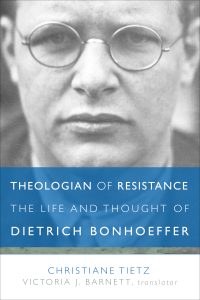 Whereas a new biography of Martin Niemöller is long overdue, one might ask: do we need another on Bonhoeffer?
Whereas a new biography of Martin Niemöller is long overdue, one might ask: do we need another on Bonhoeffer? 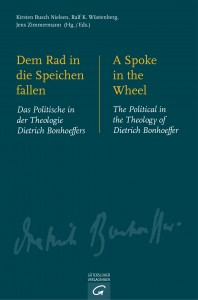 Some of the highlights of the collection include the lead essay by Wolfgang Huber in which he provides a theological profile of Bonhoeffer’s political resistance, particularly his involvement in Hans von Dohnanyi’s conspiracy in the Abwehr. Despite the limitations placed on what Bonhoeffer could put into writing during the Third Reich, Huber believes a “theology of resistance” can be teased out of Bonhoeffer’s writing during this time. His call for the Church to take a public stand in solidarity with the Jews against the repressive state; his formulation of a confession of guilt in the name of the church; his theory of a responsible life; and his trust in God’s guidance—all indicate the rudiments of a theology of resistance, Huber believes.
Some of the highlights of the collection include the lead essay by Wolfgang Huber in which he provides a theological profile of Bonhoeffer’s political resistance, particularly his involvement in Hans von Dohnanyi’s conspiracy in the Abwehr. Despite the limitations placed on what Bonhoeffer could put into writing during the Third Reich, Huber believes a “theology of resistance” can be teased out of Bonhoeffer’s writing during this time. His call for the Church to take a public stand in solidarity with the Jews against the repressive state; his formulation of a confession of guilt in the name of the church; his theory of a responsible life; and his trust in God’s guidance—all indicate the rudiments of a theology of resistance, Huber believes.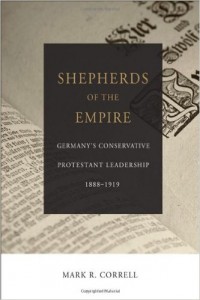 Correll begins with the court preacher Adolf Stoecker (1835-1909), who created the church networks and organizations that provided believing theologians and church leaders with a community of likeminded churchmen in which they could expound their modern conservative responses to the crisis of Protestantism at the turn of the century. Although Adolf Stoecker is best known for popularizing political anti-Semitism, his conservative political vision of a triumphant Germany, united in thrown and altar, and fending off Germany’s multiple enemies —Austria, France, Catholics, Socialists, Liberals, as well as Jews—appealed to more than just anti-Semites. While he saw the defeat of Austria in 1866 and France in 1870 as the beginning of a great awakening in Germany, he became increasingly disappointed that the Prusso-German leaders failed to rally the growing working-class to participate in this national and Protestant awakening. In addition to founding the Christian Social Workers’ Party to harness the poor for his conservative Christian cause, another central concern of his was to combat the threat of liberal or critical theology in the church, which was gaining ground at the time. To this end he founded the “Positive Union,” an organization bringing together believing church leaders, theologians, and pastors, with the purpose of maintaining control of the key leadership positions within the church and thereby limiting the destructive influences of liberal theology on the pastorate. While the Positive Union was mostly a success, his conservative and anti-Semitic political party never gained any traction among workers. Nor did his idea to do away with the state church and found an ultra-nationalist—albeit independent of the state—Volkskirche, which would work side-by-side with the state to further the cause of a conservative Christian Germany.
Correll begins with the court preacher Adolf Stoecker (1835-1909), who created the church networks and organizations that provided believing theologians and church leaders with a community of likeminded churchmen in which they could expound their modern conservative responses to the crisis of Protestantism at the turn of the century. Although Adolf Stoecker is best known for popularizing political anti-Semitism, his conservative political vision of a triumphant Germany, united in thrown and altar, and fending off Germany’s multiple enemies —Austria, France, Catholics, Socialists, Liberals, as well as Jews—appealed to more than just anti-Semites. While he saw the defeat of Austria in 1866 and France in 1870 as the beginning of a great awakening in Germany, he became increasingly disappointed that the Prusso-German leaders failed to rally the growing working-class to participate in this national and Protestant awakening. In addition to founding the Christian Social Workers’ Party to harness the poor for his conservative Christian cause, another central concern of his was to combat the threat of liberal or critical theology in the church, which was gaining ground at the time. To this end he founded the “Positive Union,” an organization bringing together believing church leaders, theologians, and pastors, with the purpose of maintaining control of the key leadership positions within the church and thereby limiting the destructive influences of liberal theology on the pastorate. While the Positive Union was mostly a success, his conservative and anti-Semitic political party never gained any traction among workers. Nor did his idea to do away with the state church and found an ultra-nationalist—albeit independent of the state—Volkskirche, which would work side-by-side with the state to further the cause of a conservative Christian Germany. Dean Stroud’s Preaching in Hitler’s Shadow: Sermons of Resistance in the Third Reich uses a broad definition of resistance along the lines of Tec’s definition. This is problematic, because his focus is preaching in the German Confessing Church. In his 48-page introduction to the historical context, Stroud does not engage the vast literature on resistance in Germany or offer his opinion on the competing definitions of resistance by scholars such as Martin Broszat, Hans Mommsen, Peter Hoffmann, Detlev Peukert, and many others. But one can easily ascertain that he considers pastors in the Confessing Church to be a part of the Resistance, that he believes resistance among pastors was more wide spread than is acknowledged, and that he views Christianity as a radical alternative to Nazism. It is self-evident to Stroud that the thirteen sermons he includes in his book are “sermons of resistance.”
Dean Stroud’s Preaching in Hitler’s Shadow: Sermons of Resistance in the Third Reich uses a broad definition of resistance along the lines of Tec’s definition. This is problematic, because his focus is preaching in the German Confessing Church. In his 48-page introduction to the historical context, Stroud does not engage the vast literature on resistance in Germany or offer his opinion on the competing definitions of resistance by scholars such as Martin Broszat, Hans Mommsen, Peter Hoffmann, Detlev Peukert, and many others. But one can easily ascertain that he considers pastors in the Confessing Church to be a part of the Resistance, that he believes resistance among pastors was more wide spread than is acknowledged, and that he views Christianity as a radical alternative to Nazism. It is self-evident to Stroud that the thirteen sermons he includes in his book are “sermons of resistance.”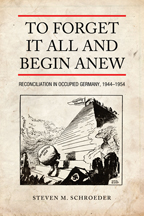 Unlike most of the studies of postwar Germany that focus on the origins of the Cold War and high stakes political maneuvering of the Allies, Schroeder takes a bottom-up approach that illuminates the less conspicuous reconciliation work of German groups such as the Association of the Victim of Nazism (VVN) and religiously-affiliated international groups such as International Fellowship of Reconciliation (IFOR), Moral Re-Armament (MRA), Pax Chrisiti, the International Council of Christians and Jews (ICCJ), and the World Council of Churches (WCC). His study compares and contrasts reconciliation, defined as “the establishment of peaceful – or at least non-hostile – relations between former enemies” in the four zones of occupation in the immediate postwar years and in East and West Germany after 1949.
Unlike most of the studies of postwar Germany that focus on the origins of the Cold War and high stakes political maneuvering of the Allies, Schroeder takes a bottom-up approach that illuminates the less conspicuous reconciliation work of German groups such as the Association of the Victim of Nazism (VVN) and religiously-affiliated international groups such as International Fellowship of Reconciliation (IFOR), Moral Re-Armament (MRA), Pax Chrisiti, the International Council of Christians and Jews (ICCJ), and the World Council of Churches (WCC). His study compares and contrasts reconciliation, defined as “the establishment of peaceful – or at least non-hostile – relations between former enemies” in the four zones of occupation in the immediate postwar years and in East and West Germany after 1949.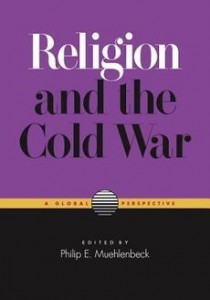 Three essays from this collection that focus on the Catholic and Protestant churches in Europe and America will be of particular interest to CCHQ readers. In his essay, “The Western Allies, German Churches, and the Emerging Cold War in Germany, 1948-1952,” JonDavid Wyneken maintains that the political leaders in the US, Britain, the Soviet Union, and in East and West Germany paid close attention to the stance of German church leaders and at times shaped their policies with the churches in mind. At the end of WWII the German churches believed that they deserved a prominent role in postwar reconstruction and promoted themselves to the Allies as offering a faith-based alternative to the appeals of atheistic Communism. Although the Allies, especially the Americans, found this appealing, they refused to grant the churches the comprehensive role they desired and imposed harsh occupation and denazification programs in their zones of occupation. Church leaders voiced strong opposition to what they called “victors’ justice” and bemoaned that the Western Allies were just making Communism more appealing to a desperate and disgruntled population.
Three essays from this collection that focus on the Catholic and Protestant churches in Europe and America will be of particular interest to CCHQ readers. In his essay, “The Western Allies, German Churches, and the Emerging Cold War in Germany, 1948-1952,” JonDavid Wyneken maintains that the political leaders in the US, Britain, the Soviet Union, and in East and West Germany paid close attention to the stance of German church leaders and at times shaped their policies with the churches in mind. At the end of WWII the German churches believed that they deserved a prominent role in postwar reconstruction and promoted themselves to the Allies as offering a faith-based alternative to the appeals of atheistic Communism. Although the Allies, especially the Americans, found this appealing, they refused to grant the churches the comprehensive role they desired and imposed harsh occupation and denazification programs in their zones of occupation. Church leaders voiced strong opposition to what they called “victors’ justice” and bemoaned that the Western Allies were just making Communism more appealing to a desperate and disgruntled population.